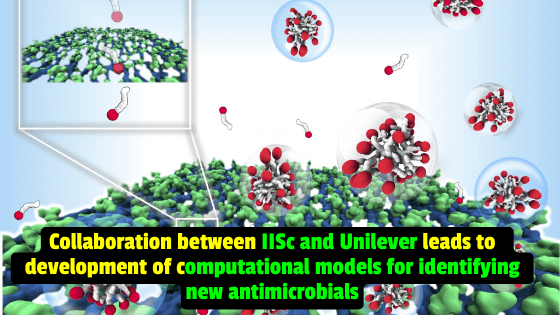The collaboration between IISc and Unilever has led to the development of computational models of bacterial cell walls that can be used to speed up screening new antimicrobials. The models can simulate the structure of the cell wall down to the level of individual atoms and have been tested with known antimicrobials for their effectiveness.
- A computational model of bacterial cell walls has been developed by researchers at the Indian Institute of Science (IISc) and Unilever.
- The models can be used to speed up the screening of antimicrobials, molecules that can kill disease-causing bacteria.
- In the computer simulation, the team recreated the cell wall structure to the level of individual atoms.
- IISc’s supercomputing facility was used to test the model’s effectiveness with several known antimicrobials.
- Furthermore, they compared different surfactant molecules’ movement through the peptidoglycan layer in E. coli.
The researchers focused on understanding the interaction between antimicrobial molecules and bacteria’s cellular barriers, such as Escherichia coli (E. coli) and Staphylococcus aureus (S. aureus). They used a supercomputing facility at IISc to create an atomistic model of the cell wall and incorporated parameters such as the sizes of sugar chains in the peptidoglycans, the orientation of peptides, and the distribution of void size. The team tested the model with known antimicrobials, such as melittin and thymol, and found that they had different interactions with the E. coli and S. aureus cell walls. In another study, they used the model to study the movement of different surfactant molecules through the peptidoglycan layer in E.coli and showed that shorter-chain surfactants killed bacteria at a higher rate than surfactants with longer chains.
Q: What is the goal of the collaboration between researchers at the Indian Institute of Science (IISc) and Unilever?
A: The collaboration aims to develop computational models of bacterial cell walls that can speed up the screening of antimicrobials, molecules that can kill disease-causing bacteria. The models will be used to narrow down the search for potential antimicrobials to a smaller subset of molecules that can be tested in the laboratory.
Q: How do antimicrobials kill bacteria?
A: Antimicrobials kill bacteria by disrupting the cell wall’s lipid membrane and destabilizing the peptidoglycan layer or by translocating through the cell wall layers and disrupting the cell membrane inside.
Q: What are the advantages of the atomistic model developed by the team?
A: The atomistic model developed by the team is a computer simulation that recreates the structure of the cell wall down to the level of individual atoms. This model can incorporate parameters such as the sizes of sugar chains in the peptidoglycans, the orientation of peptides, and the distribution of void size. This allows for a more accurate and detailed analysis of the interactions between antimicrobial molecules and bacterial cell walls.
Q: How does the tail length in surfactant molecules affect antimicrobial efficacy?
A: The team found that surfactants like laurate with shorter chains translocated more efficiently through the peptidoglycan layer in E. coli than longer-chain oleate. This was corroborated by experiments conducted by scientists in the Unilever team, which showed that shorter-chain surfactants killed bacteria at a higher rate than surfactants with longer chains.
In collaboration with Unilever, researchers at IISc have developed computational models of bacterial cell walls to help speed up the screening of antimicrobials – molecules that kill disease-causing bacteria. https://t.co/1zsPMHgErv #IIScresearch pic.twitter.com/FdLz6mc8yo
— IISc Bangalore (@iiscbangalore) January 13, 2023
REFERENCES:
Sharma P, Vaiwala R, Parthasarathi S, Patil N, Verma A, Waskar M, Raut JS, Basu JK, Ayappa KG, Interactions of surfactants with the bacterial cell wall and inner membrane: Revealing the link between aggregation and antimicrobial activity, Langmuir (2022).
https://doi.org/10.1021/acs.langmuir.2c02520
Vaiwala R, Sharma P, Ayappa KG, Differentiating interactions of antimicrobials with Gram-negative and Gram-positive bacterial cell walls using molecular dynamics simulations, Biointerphases (2022).




